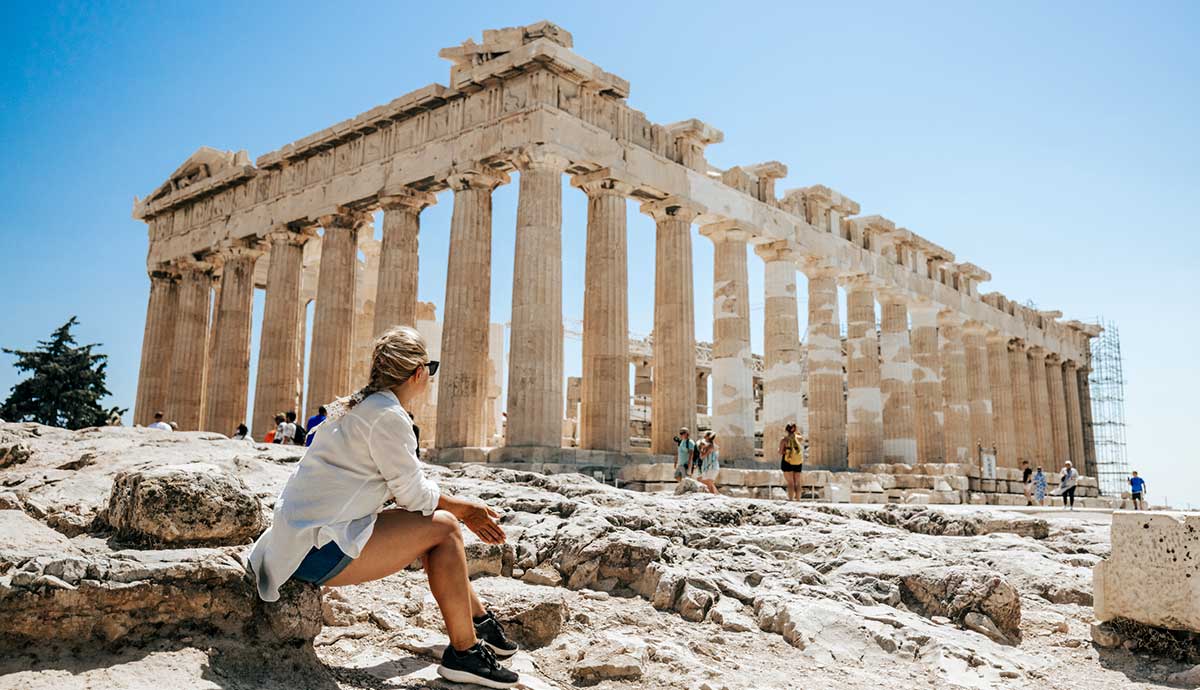
Easily one of the most recognizable buildings in all of Greece, the Parthenon watches over Athens, reminding all who live there of the history of this ancient land. Choosing when to visit this incredible landmark, is of course, an important decision for any visitor.
Weather and Climate

Athens, being the capital of Greece, has a Mediterranean climate (unsurprisingly) with mild, wet winters and warm, dry summers. Despite the rain in the winter months, tourists can expect to see sunshine most days.
The coldest months of the year are December, January, February and March when the daily mean temperature hovers around the 50s Fahrenheit (around 10°C to 16°C), while temperatures below freezing can occur. June, July, and August are the hottest months with the temperatures reaching the 80s and low 90s Fahrenheit (mid 20s to low 30s Celsius) before it begins to cool off in September, heading into the winter months.
The summer months are also characterized by strong northeasterly winds that blow through the Aegean, catching Athens in their path. The winds are dry and produce clear skies, but can be a bit of a surprise for unaware tourists.
Tourist Season

The months of May to August represent the peak tourist season, as they coincide with the warm summer. September to October is the moderate season and the colder months of November to April are the off-season.
Avoiding the crowds and making the most of the weather can be tricky to organize, but visiting the Parthenon and the surrounding Acropolis with this in mind, it’s best to plan an excursion to coincide with either end of the tourist season. The beginning of May and the end of August offer fewer tourists and generally pleasant weather.
Even during tourist season, the main bulk of the crowds can be avoided by planning a visit early in the morning. The Acropolis is open from 8am to sunset. From this location above Athens, the sunsets are particularly picturesque. Avoiding the queue in peak tourist season can be a factor, so the best time to get there is around half an hour before opening time. Tickets are available on site, but can also be pre-purchased online with a varied price range reflecting the different services available such as audio descriptions and guided tours.
Combination tickets can also be purchased which allow visitors access to various historical sites throughout Athens, including the Acropolis and the Parthenon which resides there. There are actually two entrances, and the bulk of tourists access the site through the main entrance. There is a much quieter entrance off Dionysiou Areopagitou near the Acropolis Museum. The tour groups don’t enter through here, so it’s not as packed.
At night the Acropolis is closed.
What to Expect

The Parthenon itself is one building within the Acropolis complex. To fully enjoy everything that this site has to offer, budgeting about two or three hours is best, excluding transport time. If visiting during the peak season, and on either side of it, sunblock and a pair of sunglasses are highly recommended. A good pair of walking shoes is also recommended. It takes a good 15 minutes to hike to the top of the hill, but it is a rather gentle slope, so no need to worry about actually having to climb! It is good to note that small bags are allowed, but no large backpacks.
In winter, the crowds will be much smaller and the price to enter the complex will be significantly cheaper as well. There are, however, a few days where entrance is free. March 6, April 18, May 18, the last weekend of September, October 28, and the first Sunday of every month from November through March. If the budget is tight, these are days to definitely consider, but they come with a significant increase in visitors.

Visits to any part of Greece are likely to start in Athens. It is the central hub from which most other parts of Greece are accessed by tourists from around the globe. In the heart of Athens is the very accessible Acropolis with its iconic Parthenon. While in Athens, it’s certainly worth it not to miss out on this incredible piece of ancient history!










